Reflective Journal: Communication Models, Social Media and Reflections
VerifiedAdded on 2023/06/11
|8
|1972
|492
Journal and Reflective Writing
AI Summary
This reflective journal delves into the author's understanding of communication, contrasting traditional methods with today's digitally driven interactions, particularly through social media. It explores communication as a two-way process involving encoding, decoding, and feedback, highlighting its importance in building relationships and achieving desired outcomes. The journal references Lasswell's model and Shannon and Weaver's communication barriers, noting how instant messaging has altered communication's impact. It examines social media's role in knowledge sharing, social interaction, and business communication, while also addressing drawbacks such as security issues, cyberbullying, and potential psychological effects. The reflection concludes with critical questions about social media's influence on knowledge, psychological development, and business dynamics, considering both its benefits and potential harms.
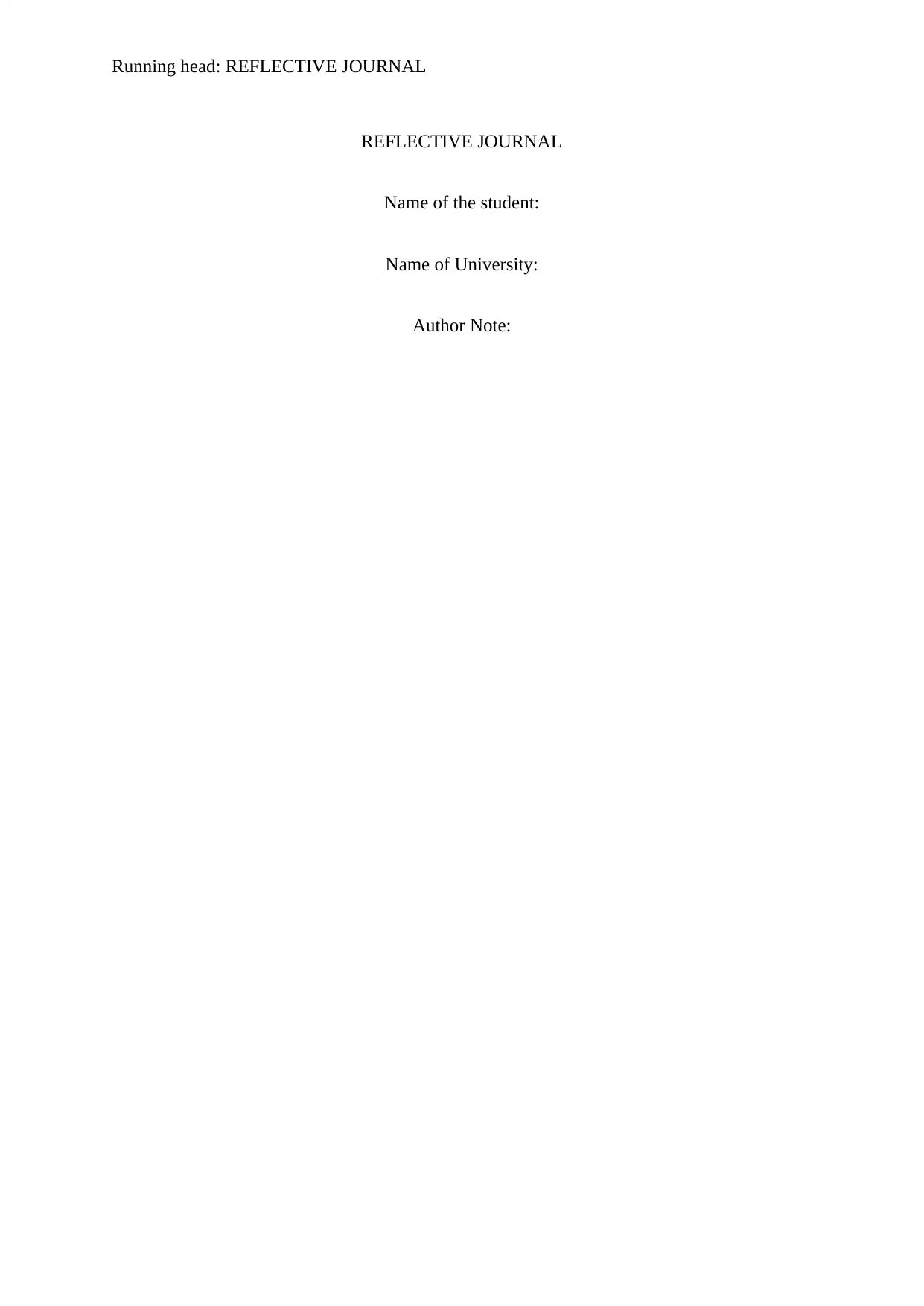
Running head: REFLECTIVE JOURNAL
REFLECTIVE JOURNAL
Name of the student:
Name of University:
Author Note:
REFLECTIVE JOURNAL
Name of the student:
Name of University:
Author Note:
Paraphrase This Document
Need a fresh take? Get an instant paraphrase of this document with our AI Paraphraser
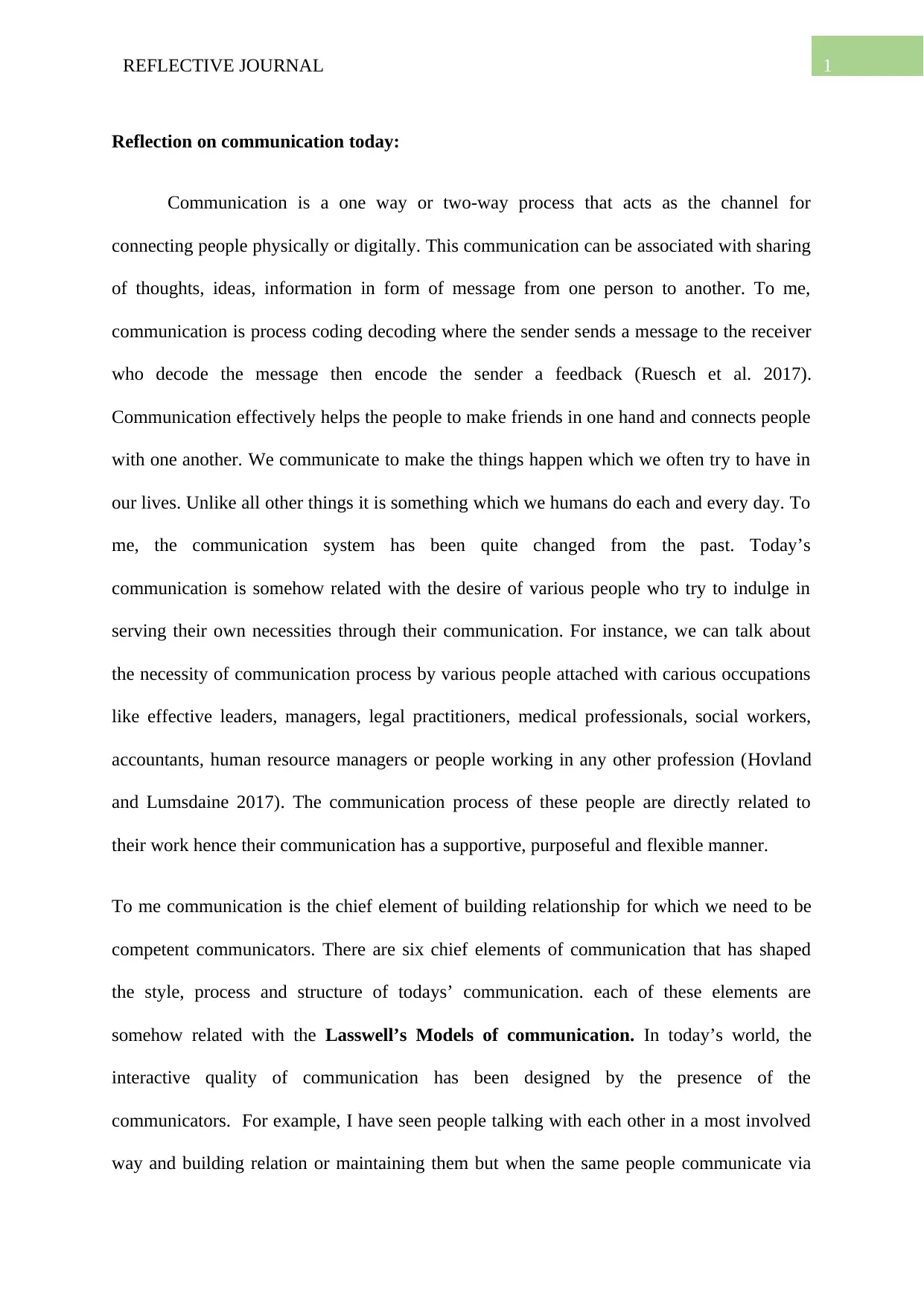
1REFLECTIVE JOURNAL
Reflection on communication today:
Communication is a one way or two-way process that acts as the channel for
connecting people physically or digitally. This communication can be associated with sharing
of thoughts, ideas, information in form of message from one person to another. To me,
communication is process coding decoding where the sender sends a message to the receiver
who decode the message then encode the sender a feedback (Ruesch et al. 2017).
Communication effectively helps the people to make friends in one hand and connects people
with one another. We communicate to make the things happen which we often try to have in
our lives. Unlike all other things it is something which we humans do each and every day. To
me, the communication system has been quite changed from the past. Today’s
communication is somehow related with the desire of various people who try to indulge in
serving their own necessities through their communication. For instance, we can talk about
the necessity of communication process by various people attached with carious occupations
like effective leaders, managers, legal practitioners, medical professionals, social workers,
accountants, human resource managers or people working in any other profession (Hovland
and Lumsdaine 2017). The communication process of these people are directly related to
their work hence their communication has a supportive, purposeful and flexible manner.
To me communication is the chief element of building relationship for which we need to be
competent communicators. There are six chief elements of communication that has shaped
the style, process and structure of todays’ communication. each of these elements are
somehow related with the Lasswell’s Models of communication. In today’s world, the
interactive quality of communication has been designed by the presence of the
communicators. For example, I have seen people talking with each other in a most involved
way and building relation or maintaining them but when the same people communicate via
Reflection on communication today:
Communication is a one way or two-way process that acts as the channel for
connecting people physically or digitally. This communication can be associated with sharing
of thoughts, ideas, information in form of message from one person to another. To me,
communication is process coding decoding where the sender sends a message to the receiver
who decode the message then encode the sender a feedback (Ruesch et al. 2017).
Communication effectively helps the people to make friends in one hand and connects people
with one another. We communicate to make the things happen which we often try to have in
our lives. Unlike all other things it is something which we humans do each and every day. To
me, the communication system has been quite changed from the past. Today’s
communication is somehow related with the desire of various people who try to indulge in
serving their own necessities through their communication. For instance, we can talk about
the necessity of communication process by various people attached with carious occupations
like effective leaders, managers, legal practitioners, medical professionals, social workers,
accountants, human resource managers or people working in any other profession (Hovland
and Lumsdaine 2017). The communication process of these people are directly related to
their work hence their communication has a supportive, purposeful and flexible manner.
To me communication is the chief element of building relationship for which we need to be
competent communicators. There are six chief elements of communication that has shaped
the style, process and structure of todays’ communication. each of these elements are
somehow related with the Lasswell’s Models of communication. In today’s world, the
interactive quality of communication has been designed by the presence of the
communicators. For example, I have seen people talking with each other in a most involved
way and building relation or maintaining them but when the same people communicate via
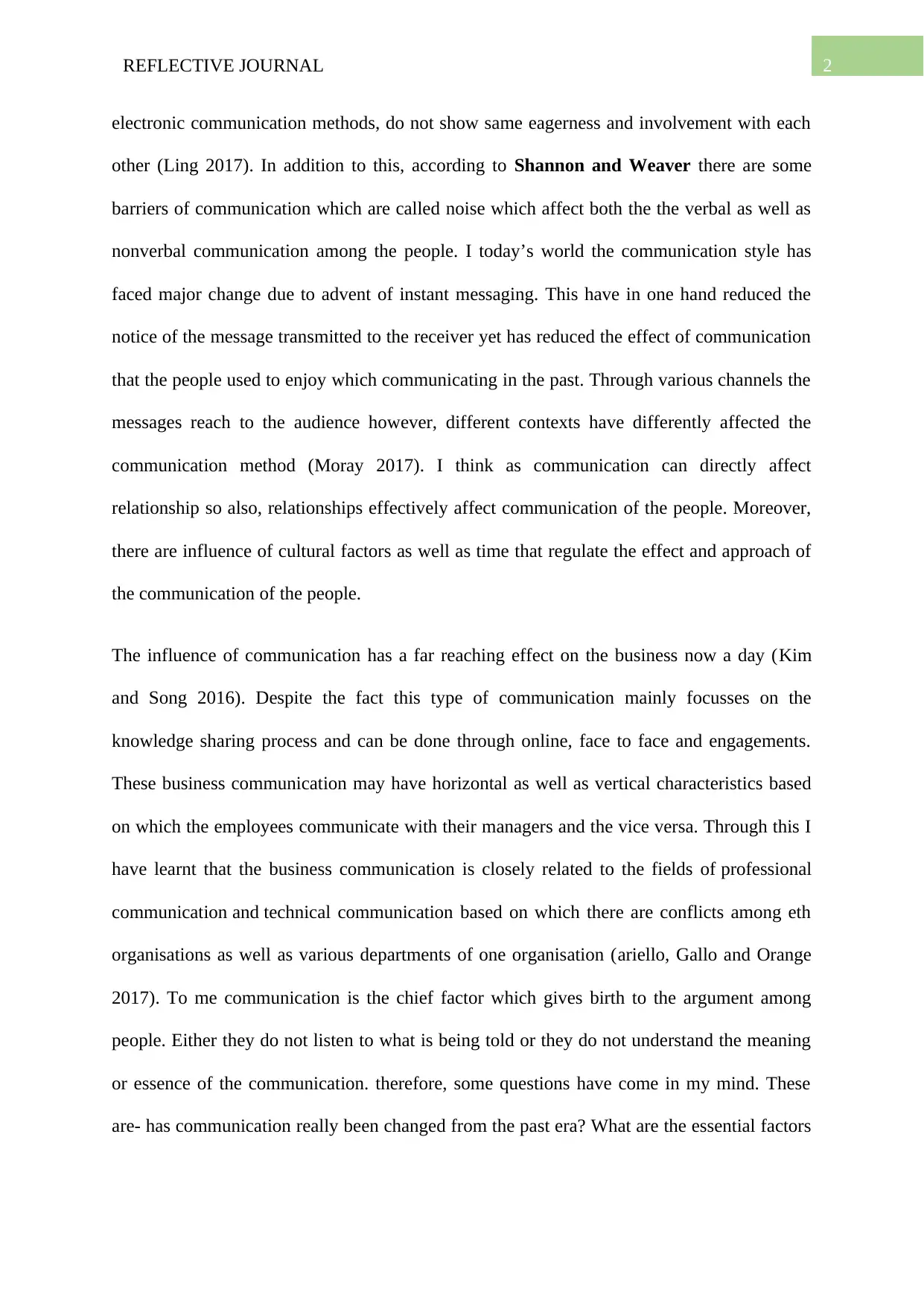
2REFLECTIVE JOURNAL
electronic communication methods, do not show same eagerness and involvement with each
other (Ling 2017). In addition to this, according to Shannon and Weaver there are some
barriers of communication which are called noise which affect both the the verbal as well as
nonverbal communication among the people. I today’s world the communication style has
faced major change due to advent of instant messaging. This have in one hand reduced the
notice of the message transmitted to the receiver yet has reduced the effect of communication
that the people used to enjoy which communicating in the past. Through various channels the
messages reach to the audience however, different contexts have differently affected the
communication method (Moray 2017). I think as communication can directly affect
relationship so also, relationships effectively affect communication of the people. Moreover,
there are influence of cultural factors as well as time that regulate the effect and approach of
the communication of the people.
The influence of communication has a far reaching effect on the business now a day (Kim
and Song 2016). Despite the fact this type of communication mainly focusses on the
knowledge sharing process and can be done through online, face to face and engagements.
These business communication may have horizontal as well as vertical characteristics based
on which the employees communicate with their managers and the vice versa. Through this I
have learnt that the business communication is closely related to the fields of professional
communication and technical communication based on which there are conflicts among eth
organisations as well as various departments of one organisation (ariello, Gallo and Orange
2017). To me communication is the chief factor which gives birth to the argument among
people. Either they do not listen to what is being told or they do not understand the meaning
or essence of the communication. therefore, some questions have come in my mind. These
are- has communication really been changed from the past era? What are the essential factors
electronic communication methods, do not show same eagerness and involvement with each
other (Ling 2017). In addition to this, according to Shannon and Weaver there are some
barriers of communication which are called noise which affect both the the verbal as well as
nonverbal communication among the people. I today’s world the communication style has
faced major change due to advent of instant messaging. This have in one hand reduced the
notice of the message transmitted to the receiver yet has reduced the effect of communication
that the people used to enjoy which communicating in the past. Through various channels the
messages reach to the audience however, different contexts have differently affected the
communication method (Moray 2017). I think as communication can directly affect
relationship so also, relationships effectively affect communication of the people. Moreover,
there are influence of cultural factors as well as time that regulate the effect and approach of
the communication of the people.
The influence of communication has a far reaching effect on the business now a day (Kim
and Song 2016). Despite the fact this type of communication mainly focusses on the
knowledge sharing process and can be done through online, face to face and engagements.
These business communication may have horizontal as well as vertical characteristics based
on which the employees communicate with their managers and the vice versa. Through this I
have learnt that the business communication is closely related to the fields of professional
communication and technical communication based on which there are conflicts among eth
organisations as well as various departments of one organisation (ariello, Gallo and Orange
2017). To me communication is the chief factor which gives birth to the argument among
people. Either they do not listen to what is being told or they do not understand the meaning
or essence of the communication. therefore, some questions have come in my mind. These
are- has communication really been changed from the past era? What are the essential factors
⊘ This is a preview!⊘
Do you want full access?
Subscribe today to unlock all pages.

Trusted by 1+ million students worldwide
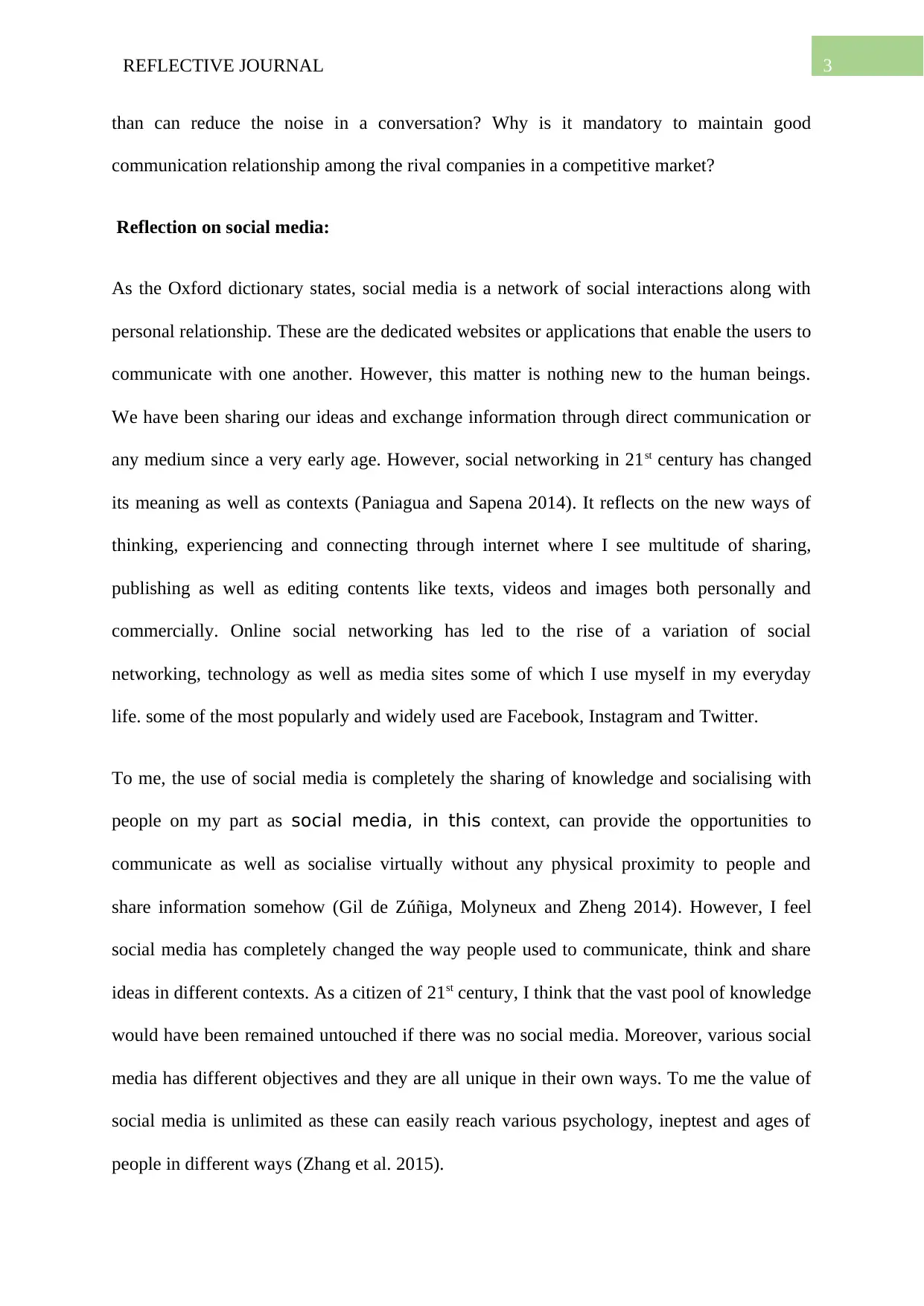
3REFLECTIVE JOURNAL
than can reduce the noise in a conversation? Why is it mandatory to maintain good
communication relationship among the rival companies in a competitive market?
Reflection on social media:
As the Oxford dictionary states, social media is a network of social interactions along with
personal relationship. These are the dedicated websites or applications that enable the users to
communicate with one another. However, this matter is nothing new to the human beings.
We have been sharing our ideas and exchange information through direct communication or
any medium since a very early age. However, social networking in 21st century has changed
its meaning as well as contexts (Paniagua and Sapena 2014). It reflects on the new ways of
thinking, experiencing and connecting through internet where I see multitude of sharing,
publishing as well as editing contents like texts, videos and images both personally and
commercially. Online social networking has led to the rise of a variation of social
networking, technology as well as media sites some of which I use myself in my everyday
life. some of the most popularly and widely used are Facebook, Instagram and Twitter.
To me, the use of social media is completely the sharing of knowledge and socialising with
people on my part as social media, in this context, can provide the opportunities to
communicate as well as socialise virtually without any physical proximity to people and
share information somehow (Gil de Zúñiga, Molyneux and Zheng 2014). However, I feel
social media has completely changed the way people used to communicate, think and share
ideas in different contexts. As a citizen of 21st century, I think that the vast pool of knowledge
would have been remained untouched if there was no social media. Moreover, various social
media has different objectives and they are all unique in their own ways. To me the value of
social media is unlimited as these can easily reach various psychology, ineptest and ages of
people in different ways (Zhang et al. 2015).
than can reduce the noise in a conversation? Why is it mandatory to maintain good
communication relationship among the rival companies in a competitive market?
Reflection on social media:
As the Oxford dictionary states, social media is a network of social interactions along with
personal relationship. These are the dedicated websites or applications that enable the users to
communicate with one another. However, this matter is nothing new to the human beings.
We have been sharing our ideas and exchange information through direct communication or
any medium since a very early age. However, social networking in 21st century has changed
its meaning as well as contexts (Paniagua and Sapena 2014). It reflects on the new ways of
thinking, experiencing and connecting through internet where I see multitude of sharing,
publishing as well as editing contents like texts, videos and images both personally and
commercially. Online social networking has led to the rise of a variation of social
networking, technology as well as media sites some of which I use myself in my everyday
life. some of the most popularly and widely used are Facebook, Instagram and Twitter.
To me, the use of social media is completely the sharing of knowledge and socialising with
people on my part as social media, in this context, can provide the opportunities to
communicate as well as socialise virtually without any physical proximity to people and
share information somehow (Gil de Zúñiga, Molyneux and Zheng 2014). However, I feel
social media has completely changed the way people used to communicate, think and share
ideas in different contexts. As a citizen of 21st century, I think that the vast pool of knowledge
would have been remained untouched if there was no social media. Moreover, various social
media has different objectives and they are all unique in their own ways. To me the value of
social media is unlimited as these can easily reach various psychology, ineptest and ages of
people in different ways (Zhang et al. 2015).
Paraphrase This Document
Need a fresh take? Get an instant paraphrase of this document with our AI Paraphraser
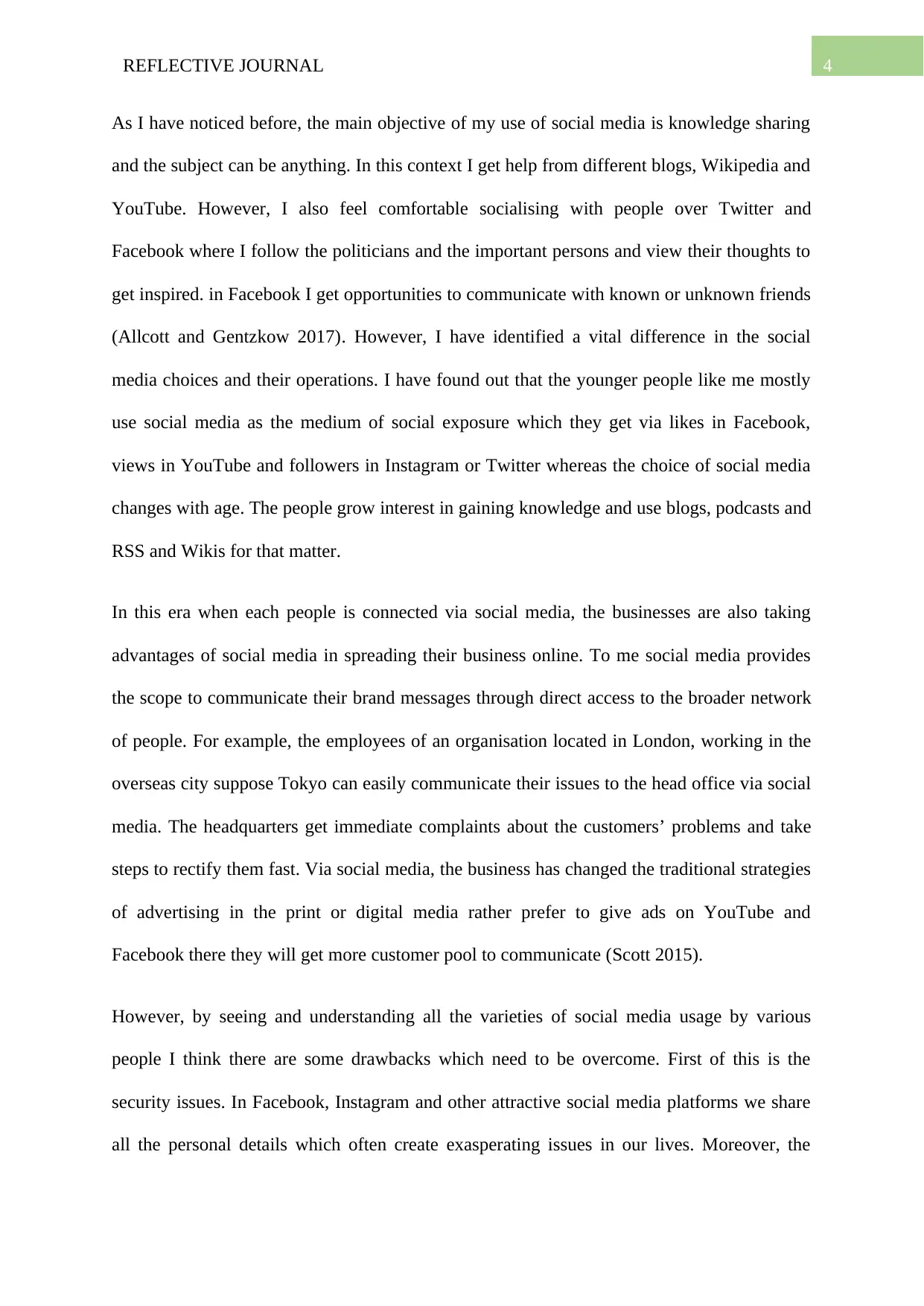
4REFLECTIVE JOURNAL
As I have noticed before, the main objective of my use of social media is knowledge sharing
and the subject can be anything. In this context I get help from different blogs, Wikipedia and
YouTube. However, I also feel comfortable socialising with people over Twitter and
Facebook where I follow the politicians and the important persons and view their thoughts to
get inspired. in Facebook I get opportunities to communicate with known or unknown friends
(Allcott and Gentzkow 2017). However, I have identified a vital difference in the social
media choices and their operations. I have found out that the younger people like me mostly
use social media as the medium of social exposure which they get via likes in Facebook,
views in YouTube and followers in Instagram or Twitter whereas the choice of social media
changes with age. The people grow interest in gaining knowledge and use blogs, podcasts and
RSS and Wikis for that matter.
In this era when each people is connected via social media, the businesses are also taking
advantages of social media in spreading their business online. To me social media provides
the scope to communicate their brand messages through direct access to the broader network
of people. For example, the employees of an organisation located in London, working in the
overseas city suppose Tokyo can easily communicate their issues to the head office via social
media. The headquarters get immediate complaints about the customers’ problems and take
steps to rectify them fast. Via social media, the business has changed the traditional strategies
of advertising in the print or digital media rather prefer to give ads on YouTube and
Facebook there they will get more customer pool to communicate (Scott 2015).
However, by seeing and understanding all the varieties of social media usage by various
people I think there are some drawbacks which need to be overcome. First of this is the
security issues. In Facebook, Instagram and other attractive social media platforms we share
all the personal details which often create exasperating issues in our lives. Moreover, the
As I have noticed before, the main objective of my use of social media is knowledge sharing
and the subject can be anything. In this context I get help from different blogs, Wikipedia and
YouTube. However, I also feel comfortable socialising with people over Twitter and
Facebook where I follow the politicians and the important persons and view their thoughts to
get inspired. in Facebook I get opportunities to communicate with known or unknown friends
(Allcott and Gentzkow 2017). However, I have identified a vital difference in the social
media choices and their operations. I have found out that the younger people like me mostly
use social media as the medium of social exposure which they get via likes in Facebook,
views in YouTube and followers in Instagram or Twitter whereas the choice of social media
changes with age. The people grow interest in gaining knowledge and use blogs, podcasts and
RSS and Wikis for that matter.
In this era when each people is connected via social media, the businesses are also taking
advantages of social media in spreading their business online. To me social media provides
the scope to communicate their brand messages through direct access to the broader network
of people. For example, the employees of an organisation located in London, working in the
overseas city suppose Tokyo can easily communicate their issues to the head office via social
media. The headquarters get immediate complaints about the customers’ problems and take
steps to rectify them fast. Via social media, the business has changed the traditional strategies
of advertising in the print or digital media rather prefer to give ads on YouTube and
Facebook there they will get more customer pool to communicate (Scott 2015).
However, by seeing and understanding all the varieties of social media usage by various
people I think there are some drawbacks which need to be overcome. First of this is the
security issues. In Facebook, Instagram and other attractive social media platforms we share
all the personal details which often create exasperating issues in our lives. Moreover, the
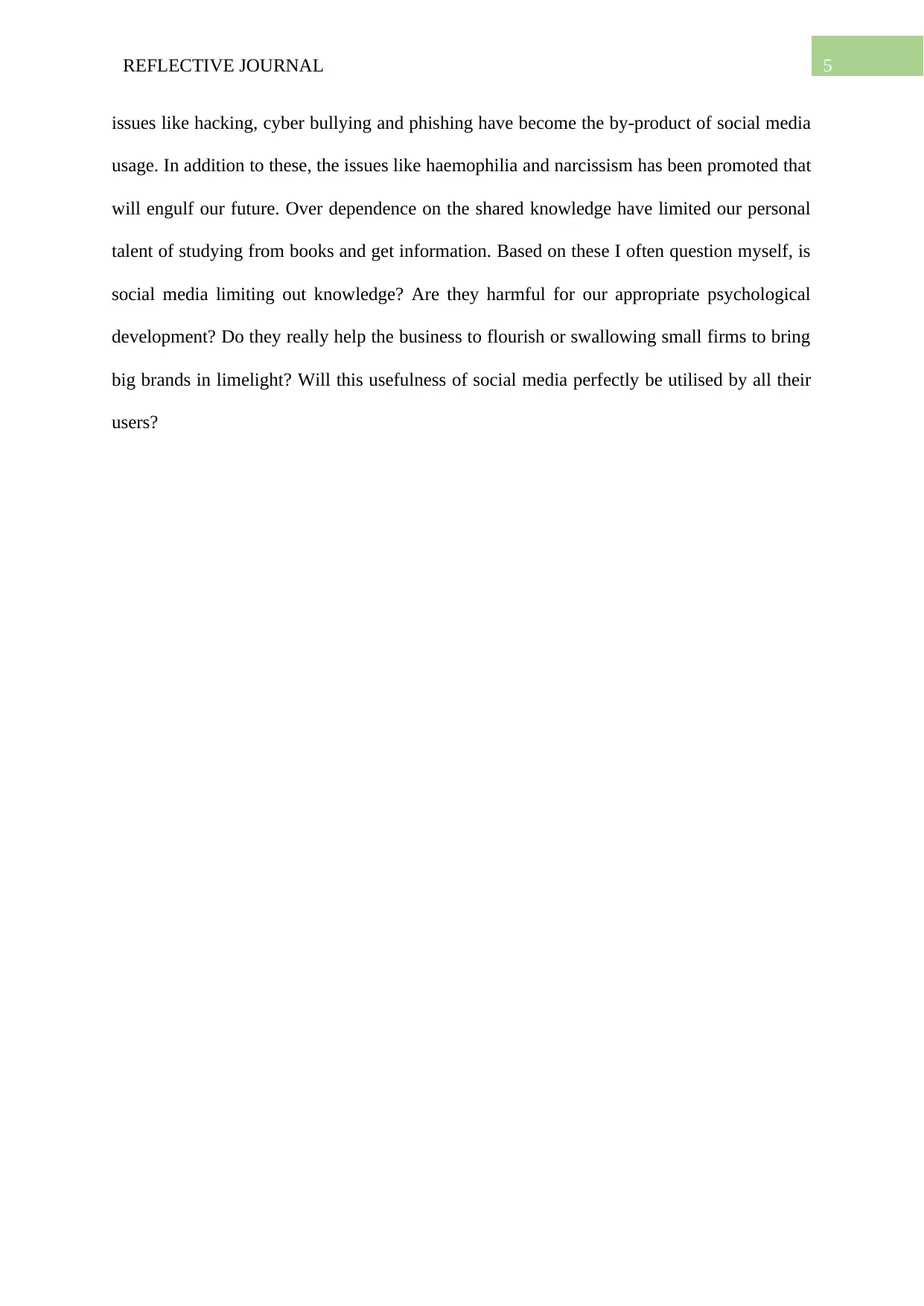
5REFLECTIVE JOURNAL
issues like hacking, cyber bullying and phishing have become the by-product of social media
usage. In addition to these, the issues like haemophilia and narcissism has been promoted that
will engulf our future. Over dependence on the shared knowledge have limited our personal
talent of studying from books and get information. Based on these I often question myself, is
social media limiting out knowledge? Are they harmful for our appropriate psychological
development? Do they really help the business to flourish or swallowing small firms to bring
big brands in limelight? Will this usefulness of social media perfectly be utilised by all their
users?
issues like hacking, cyber bullying and phishing have become the by-product of social media
usage. In addition to these, the issues like haemophilia and narcissism has been promoted that
will engulf our future. Over dependence on the shared knowledge have limited our personal
talent of studying from books and get information. Based on these I often question myself, is
social media limiting out knowledge? Are they harmful for our appropriate psychological
development? Do they really help the business to flourish or swallowing small firms to bring
big brands in limelight? Will this usefulness of social media perfectly be utilised by all their
users?
⊘ This is a preview!⊘
Do you want full access?
Subscribe today to unlock all pages.

Trusted by 1+ million students worldwide
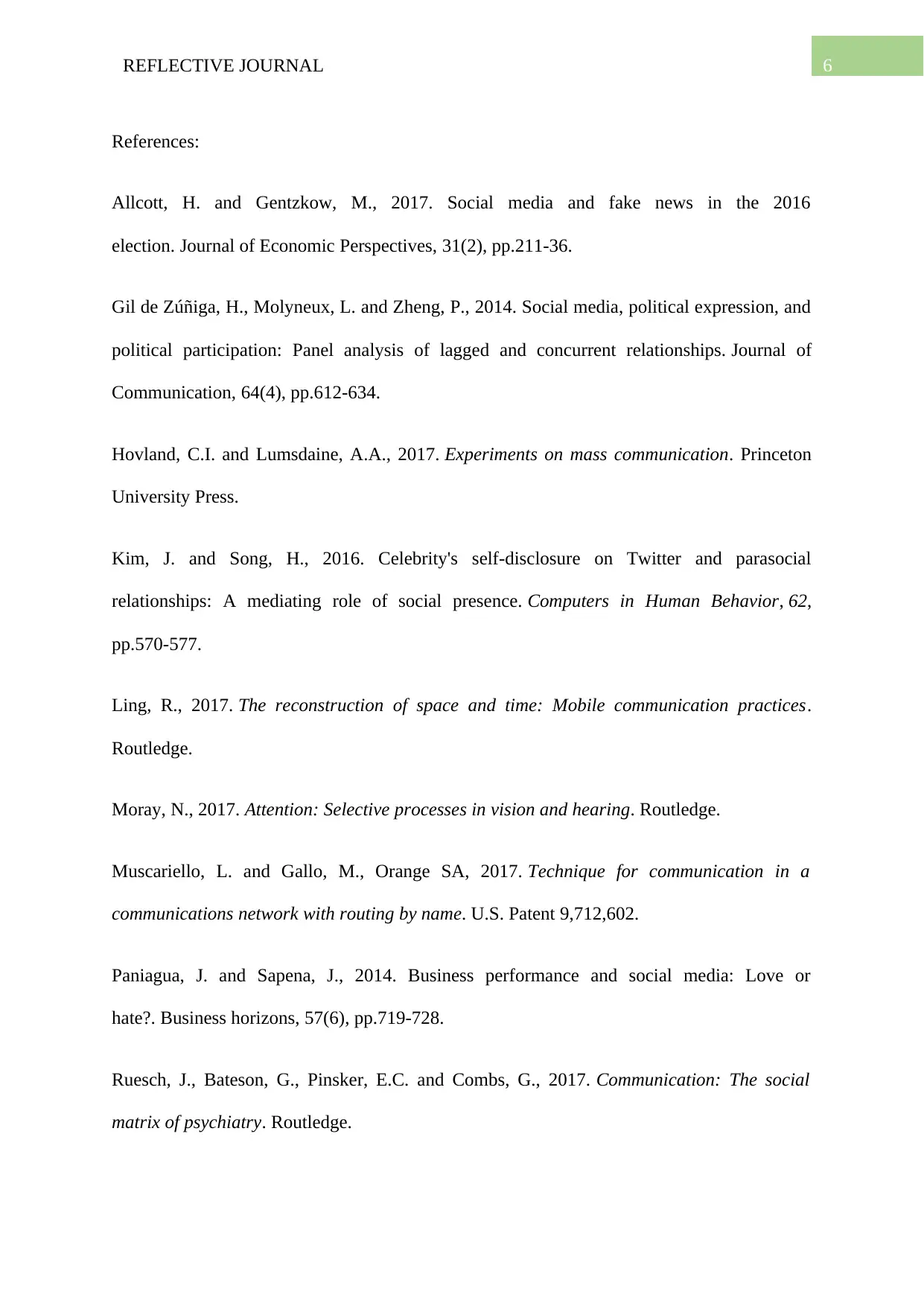
6REFLECTIVE JOURNAL
References:
Allcott, H. and Gentzkow, M., 2017. Social media and fake news in the 2016
election. Journal of Economic Perspectives, 31(2), pp.211-36.
Gil de Zúñiga, H., Molyneux, L. and Zheng, P., 2014. Social media, political expression, and
political participation: Panel analysis of lagged and concurrent relationships. Journal of
Communication, 64(4), pp.612-634.
Hovland, C.I. and Lumsdaine, A.A., 2017. Experiments on mass communication. Princeton
University Press.
Kim, J. and Song, H., 2016. Celebrity's self-disclosure on Twitter and parasocial
relationships: A mediating role of social presence. Computers in Human Behavior, 62,
pp.570-577.
Ling, R., 2017. The reconstruction of space and time: Mobile communication practices.
Routledge.
Moray, N., 2017. Attention: Selective processes in vision and hearing. Routledge.
Muscariello, L. and Gallo, M., Orange SA, 2017. Technique for communication in a
communications network with routing by name. U.S. Patent 9,712,602.
Paniagua, J. and Sapena, J., 2014. Business performance and social media: Love or
hate?. Business horizons, 57(6), pp.719-728.
Ruesch, J., Bateson, G., Pinsker, E.C. and Combs, G., 2017. Communication: The social
matrix of psychiatry. Routledge.
References:
Allcott, H. and Gentzkow, M., 2017. Social media and fake news in the 2016
election. Journal of Economic Perspectives, 31(2), pp.211-36.
Gil de Zúñiga, H., Molyneux, L. and Zheng, P., 2014. Social media, political expression, and
political participation: Panel analysis of lagged and concurrent relationships. Journal of
Communication, 64(4), pp.612-634.
Hovland, C.I. and Lumsdaine, A.A., 2017. Experiments on mass communication. Princeton
University Press.
Kim, J. and Song, H., 2016. Celebrity's self-disclosure on Twitter and parasocial
relationships: A mediating role of social presence. Computers in Human Behavior, 62,
pp.570-577.
Ling, R., 2017. The reconstruction of space and time: Mobile communication practices.
Routledge.
Moray, N., 2017. Attention: Selective processes in vision and hearing. Routledge.
Muscariello, L. and Gallo, M., Orange SA, 2017. Technique for communication in a
communications network with routing by name. U.S. Patent 9,712,602.
Paniagua, J. and Sapena, J., 2014. Business performance and social media: Love or
hate?. Business horizons, 57(6), pp.719-728.
Ruesch, J., Bateson, G., Pinsker, E.C. and Combs, G., 2017. Communication: The social
matrix of psychiatry. Routledge.
Paraphrase This Document
Need a fresh take? Get an instant paraphrase of this document with our AI Paraphraser
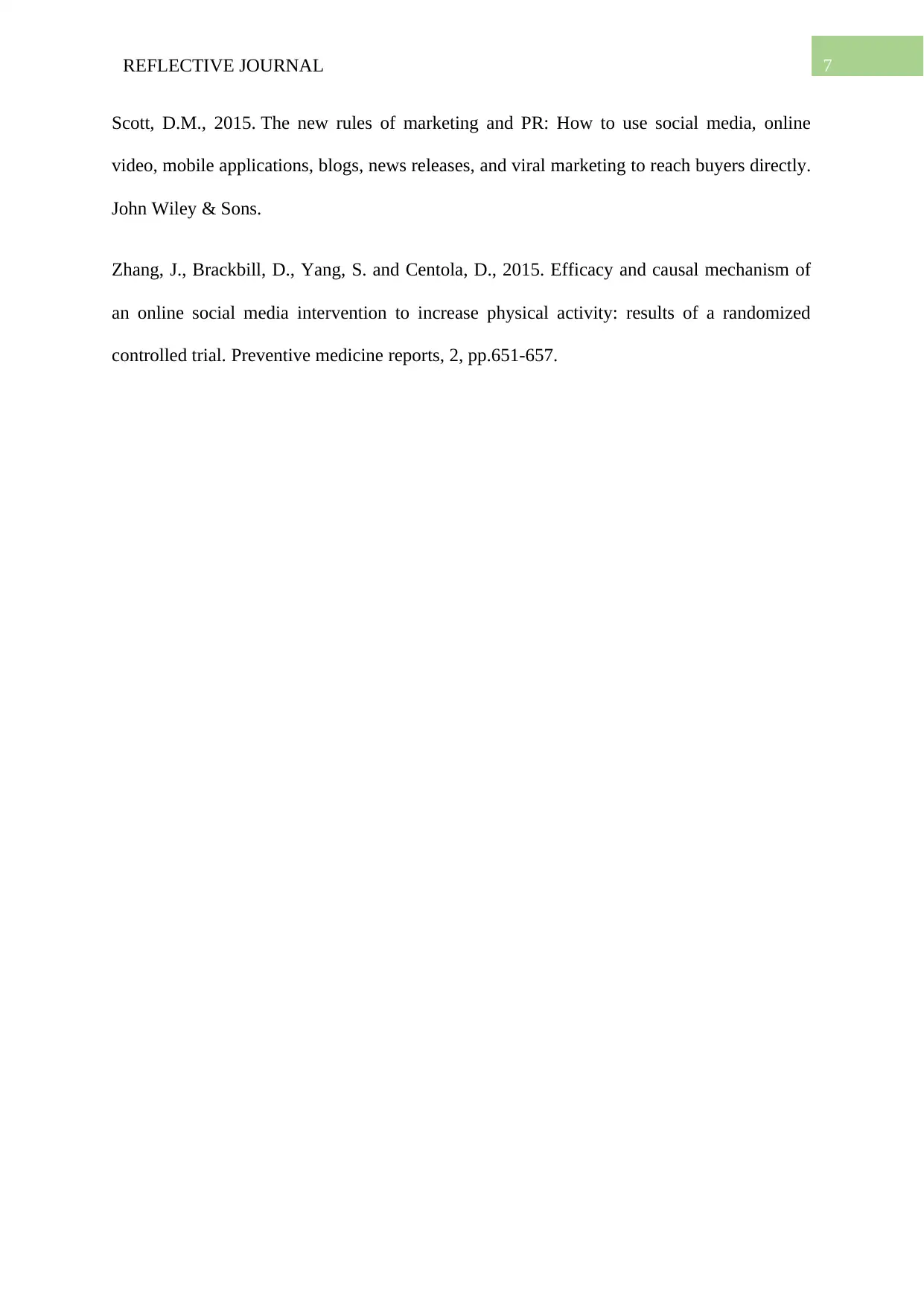
7REFLECTIVE JOURNAL
Scott, D.M., 2015. The new rules of marketing and PR: How to use social media, online
video, mobile applications, blogs, news releases, and viral marketing to reach buyers directly.
John Wiley & Sons.
Zhang, J., Brackbill, D., Yang, S. and Centola, D., 2015. Efficacy and causal mechanism of
an online social media intervention to increase physical activity: results of a randomized
controlled trial. Preventive medicine reports, 2, pp.651-657.
Scott, D.M., 2015. The new rules of marketing and PR: How to use social media, online
video, mobile applications, blogs, news releases, and viral marketing to reach buyers directly.
John Wiley & Sons.
Zhang, J., Brackbill, D., Yang, S. and Centola, D., 2015. Efficacy and causal mechanism of
an online social media intervention to increase physical activity: results of a randomized
controlled trial. Preventive medicine reports, 2, pp.651-657.
1 out of 8
Related Documents
Your All-in-One AI-Powered Toolkit for Academic Success.
+13062052269
info@desklib.com
Available 24*7 on WhatsApp / Email
![[object Object]](/_next/static/media/star-bottom.7253800d.svg)
Unlock your academic potential
Copyright © 2020–2025 A2Z Services. All Rights Reserved. Developed and managed by ZUCOL.




